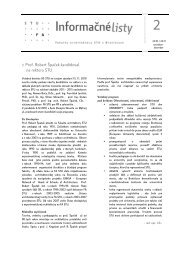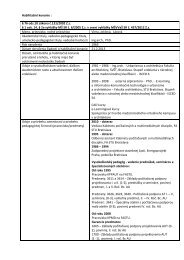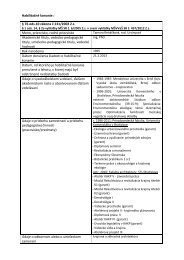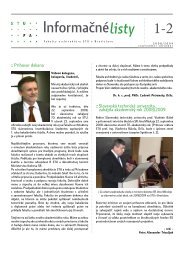ALFA 3-4/2005 - Fakulta architektúry STU
ALFA 3-4/2005 - Fakulta architektúry STU
ALFA 3-4/2005 - Fakulta architektúry STU
Create successful ePaper yourself
Turn your PDF publications into a flip-book with our unique Google optimized e-Paper software.
Ročník 9<br />
3-4 / <strong>2005</strong> ARCHITEKTONICKÉ LISTY FA <strong>STU</strong><br />
also provision of recreational hospital facilities. Recreational<br />
facilities for the wider hospital setting included provision of:<br />
- Shopping areas<br />
- Cafés and restaurant<br />
- Cinema<br />
- Swimming pool and Keep-fit facilities<br />
- Personal services such as hair and beauty treatments<br />
- Games and video hire<br />
- Alternative therapies including aromatherapy, reflexology and<br />
massage.<br />
Provision of such facilities was seen as an opportunity to keep a<br />
sense of normality and would provide for family activity where<br />
the patient could spend time alone or in the company of their<br />
family and friends.<br />
According to NHS research (2002) respondents were asked to<br />
comment on their views on each of these facilities. The facility,<br />
which received the most praise, was the shopping area, with<br />
31.7 percent describing this facility as very good and a further<br />
40.4 percent as good. In contrast, just sixteen respondents<br />
(2.3 percent) were negative. The second most popular facility was<br />
the cafes or restaurant, with similar numbers as with the shopping<br />
areas rating this facility as very good 29.5 percent and good<br />
40.2 percent. Those, who rated this facility as poor or very poor<br />
accounted for just 4.1 percent. In comparison, most of the other<br />
facilities were generally rated as being satisfactory, ranging from<br />
33.4 percent in relation to the garden outdoor areas, to 10.6 per<br />
the TV facilities 33.0 percent and car parking 31.2 percent.<br />
Enable family members to be a part of healing process<br />
Today’s health care designers simultaneously recognize that<br />
welcoming the family member, as a part of the patient care team,<br />
is a positive consideration for all parties. In fact, some studies<br />
have indicated that it is common for family members to suffer<br />
more psychological distress than the patients themselves and<br />
also, a family member’s distress can be contagious to the patient<br />
and it is possible that distressed family members might get in<br />
the way of professionals caring for the patient.<br />
Therefore a design of hospital’s spaces is including a family<br />
lounge area that provides privacy for a frightened, angry of<br />
overwhelmed spouse, parent or child is an important<br />
consideration from a clinical and healing standpoint. We can also<br />
make overall patient experience less isolating by increasing<br />
the size of patient room, what enables family members to be<br />
accommodated together with patient.<br />
In fact single rooms are markedly better than multi-bed rooms for<br />
supporting or accommodating the presence of family and friends.<br />
Single rooms in supporting social support provide more space and<br />
furniture than multi-bed rooms to accommodate family presence.<br />
Conclusion<br />
The main aim of this article has been to investigate the role<br />
of hospital environment in healing process of patients and<br />
- 41 -<br />
understand architectural impacts, which may bring contribution to<br />
hospital humanization. This better understanding of architectural<br />
impacts will hopefully help us create even more appropriate health<br />
care environments. With the growing wealth of information and<br />
understanding, health care designers, , can create the more<br />
sensitive environments that will address the physical and<br />
emotional needs of the patients, their families and the caregivers.<br />
Humanization of hospitals is not about to create simply nicer and<br />
pleasing buildings, it is more about hospitals that actually help<br />
patients recover, be safer, and help staff do their jobs better.<br />
Hospitals are complex systems where it is difficult to isolate<br />
the impact of single factors. There are aspects, which play a great<br />
role in terms of humanization of environment:<br />
Entrance hall of hospitals remind often of hotel lobbies.

















